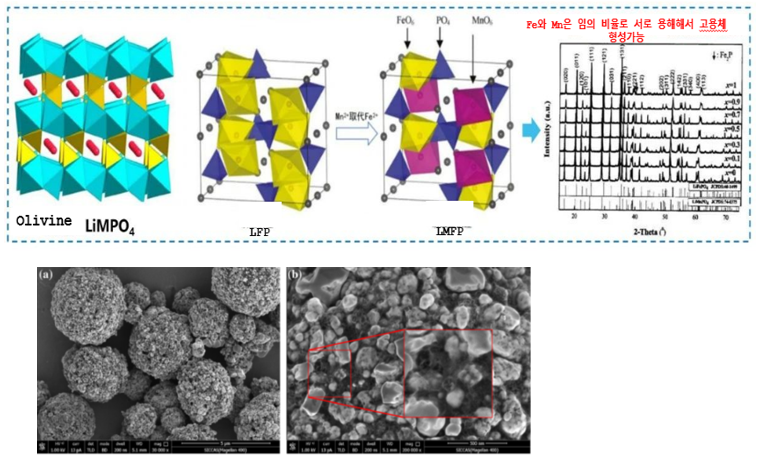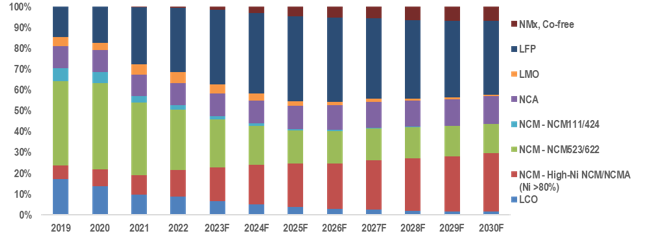The year 2021 was a year of explosive interest in lithium iron phosphate (LFP, LiFePO4) batteries in China, and the trend has been strong through the first half of 2023. The share of LFP batteries in electric vehicles also increased from 17% in 2020 to 27% in 2021 and 36% in 2022.
The share
of LFP battery-powered electric vehicles sold in China has surpassed the share
of NCM (nickel-cobalt-manganese) or NCA (nickel-cobalt-aluminum) batteries
since September 2020.
Currently,
most LFP batteries are produced by Chinese companies, but Tesla, as well as
Volkswagen, Ford, and Stellantis, are also showing interest in LFP batteries.
Lithium
iron phosphate (LiFePO4) batteries are gaining attention for large-scale
applications due to their cost-effectiveness, safety, and extended service
life. Unlike traditional lithium-ion batteries, LiFePO4 batteries can be
produced inexpensively without using cobalt. They exhibit robust safety
features, maintaining performance even in high temperatures and during
overcharging. Furthermore, the expiration of key patents around 2022 eliminates
concerns about patent fees or infringement risks, paving the way for broader
adoption. To grasp the characteristics, advantages, and disadvantages of
lithium iron phosphate (LiFePO4) secondary batteries, a comprehensive
understanding of lithium-ion batteries and insights into the strengths and
limitations of LiFePO4 cathode materials is crucial. This knowledge forms the
foundation for anticipating the future development direction of LiFePO4
secondary batteries.
Lithium
iron phosphate batteries, like the ones in the 2021 Tesla Model 3, currently
offer a range of about 400 kilometers, with the Model 3 achieving 407
kilometers. Their cost advantage, stemming from the use of inexpensive iron, is
amplified amid rising prices of raw materials for ternary systems like cobalt
and nickel. The safety edge of lithium iron phosphate, with its olivine
structure, is evident in its resistance to fire or explosion reactions even at
300 degrees Celsius and 260% overcharging. This characteristic eliminates the
need for contingency funds to address safety incidents, benefiting battery
companies and automakers.
Although
there are still many challenges to be addressed, it is thought that another
breakthrough in olivine lithium iron phosphate is possible if the performance
of bulk lithium iron phosphate, effective compounding with graphene, and the
performance of LiMnPO4 are realized.
Recently,
LMFP batteries with manganese mixed have been attracting attention as a new
technology that can overcome these limitations. The energy density can be
increased by about 15-20% at a similar price. Chinese companies such as CATL,
BYD, and Guoxuan have also developed LMFP-based batteries with similar
technologies and entered the commercialization stage.
This
report delves into the types and traits of lithium-ion battery cathode materials,
focusing on the noteworthy lithium iron phosphate (LFP, LMFP) cathodes. We will
provide a detailed examination of their characteristics, alongside a discussion
on development status and manufacturing processes. Moreover, this report explores
the market outlook and major companies in lithium iron phosphate (LFP, LMFP)
cathode materials, providing insights into the current status of LFP-equipped
automakers and battery companies.
The
strong point of this report is...
①
Detailed explanation of the types and characteristics of lithium iron phosphate
and lithium-ion battery cathode materials
②
Technical feature comparison analysis between lithium iron phosphate material
and ternary materials
③ Summary
of the manufacturing process of lithium iron phosphate and the latest trends in
technological development
④ Lithium
iron phosphate production capacity and usage prospects for major companies
(approximately 50 companies)
⑤ Beneficial for companies or individuals looking to enter or conduct new studies in the lithium iron phosphate material market


Index
<2023
Edition> LFP Cathode Materials for Lithium-Ion Secondary
Batteries: Status and Market Outlook
1. Lithium-ion Battery Overview
1-1. History of Li-ion Batteries
1-2. Li-ion Battery Types and Features
1-3. The Operating Principle of Li-ion Batteries
1-4. Li-ion Battery Components
1-5. Applications of lithium-ion Batteries
2.
Types and Characteristics of Lithium-ion Battery Cathode Materials
2-1. Structure and Properties of Li-ion Battery Cathode
Materials
2-2. Oxide-based Cathode Material Structure and Electrochemical
Properties
2-2-1. Layered Oxide
2-2-2. Li and Mn-rich Oxide
2-2-3. Disordered Rock-Salt Oxides
2-2-4. Spinel Oxides
2.3. Structure and Electrochemical Properties of
Polyanion-based Cathode Materials
2.3.1 Olivine-type Polyanion Oxide
2.3.2 Other Polyanion-Based Cathode Active
Materials
3. Status of the development of lithium iron phosphate
(LFP/LMFP) cathode materials
3-1.
Directions for the development of LFP/LMFP cathode materials
3-2.
Development history of LFP/LMFP cathode materials
3-3.
Basic characteristics of LFP/LMFP cathode materials
3-3-1.
Crystal Structure
3-3-2.
Lithium migration and phase change mechanism during charge and discharge
3-3-3.
Electrical Conductivity
3-3-4.
Defects in the Structure
3-3-5.
Energy Density
3-3-6.
Temperature dependence
3-3-7.
Lifetime Characteristics
3-4.
LFP cathode material manufacturing process
3-4-1.
Synthesis
3-4-2.
Synthesis Materials and Heat Treatment
3-4-3.
Manufacturing Process of LFP precursor
3-5.
Trends in the development of LFP based cathode materials
3-5-1
Controlling Particle Shape
3-5-2.
Carbon-based composites
3-5-3.
Doping
3-5-4.
Increase in Energy Density through Manganese Substitution (LMFP)
3-5-5.
Other Olivine-based cathode material technology development trends
①
LiMnPO4 (LMP) ② LiCoPO4, LiNiPO4
(LCP, LNP)
3-6. Technological Developments in Lithium Iron
Phosphate (LMFP) Cathode Materials
3-6-1. Background of LMFP cathode material research
3-6-2. LMFP cathode material manufacturing method
3-6-3. Performance improvement strategy for LMFP
cathode materials
3-6-4. Overall Results and Outlook for LMFP Cathode
Materials
3-7. Future Research and Development Directions for
LFP Cathode Materials
4. LFP Market and Company Status
4-1. LFP-based secondary battery market status
4-2.
Major LFP Cathode Material Producers
4-2-1. Dynanonic
4-2-2. Guoxuan(Gotion)
4-2-3. BTR(Lopal)
4-2-4. Hunan Yuneng
4-2-5. Hubei Wanrun
4-2-6. BYD
4-2-7. Chongqing Terui
4-2-8. Pulead
4-2-9. Anda
4-2-10. Johnson Matthey
4-2-11. Tianjin STL
4-2-12. Valence
4-2-13.
RT Hi-Tech
4-2-14.
Changzhou Liyuan
4-2-15.
Shandong Fengyuan
4-2-16.
Chengdu Jintang Shidai
4-2-17.
YOUSHAN TECHNOLOGY
4-2-18.
HEFEI YOUNGY ENERGY MATERIALS CO.,LTD.
4-2-19.
Sichuan Langsheng New Energy Technology Co., Ltd.
4-2-20.
Hunan Pengbo New Materials
4-2-21.
Fujian Zijin Liyuan
4-2-22.
Jiangxi Zhili Technology
4-2-23.
Xiexin Lidian
4-2-24.
Others
(Shenghua(Fulin PM), Annada, CNNC, Yunxiang,
KTC, Haichuang New Energy, Zhongtian Xingcai Cylico, Yunnan Yeyang, Deyang
Weixu, Xiamen Xingrong, Yibin Tianyuan, Wanhua Chemical,CALB, Bangsheng New
Energy, Tinci, BASF, Dupont, Aleees, Tatung, Formosa, CAEC, ONE, RFsemi,
Zaigle, KPS)
4-3.
Status of Complete Vehicle Manufacturers Applying LFP Materials
4-4.
Status of LFP Battery Companies
5. References

